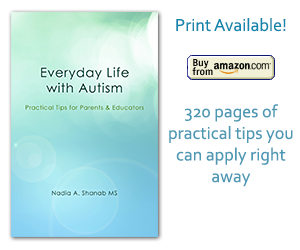Environmental Enrichment Therapy
Nadia Shanab | autism, general advice, parenting, tips4 May 2015

Even though research in this domain is not new, we started hearing more and more about this interesting kind of therapy. Compared to traditional therapies, like ABA (Applied Behavior Analysis), speech therapy, occupational therapy, just to mention some, Environmental Enrichment Therapy is:
- Convenient: parents can do it at home, no need to run to places at certain times.
- Low-cost: materials needed are inexpensive, and no therapists’ fees are paid.
- Simple and easy to put into practice.
- Effective: research shows great results compared to traditional therapies, 47% vs 7%.
- Fast: results show much faster compared to other traditional terapies.
- Never too late to start.
Children and individuals on the autism spectrum suffer, with different degrees, from sensory integreation issues. Their senses, like vision, heraring, olfactory, taste, and touch (tactile), are affeted in very wide and different ways. Some have very sensitive ears, others have very sensitive noses, some hate to be touched, to the contrary of those who love to hug and beeing hugged. Foods’ taste and textures is another element to consider. Bright light and sun light can be very annoying to many people with ASD (Autism Spectrum Disorder). In these cases, the senses are overstimulated. The opposite, being understimulated, can be as a serious of and issue too.
Needless to say that senses in human beings are the most basic and important means to rely on to survive and go about in this world. Consequently, any imbalance in any of the senses may lead to:
- Behavioral issuses (ex: covering ears or eyes)
- Throwing up (due to an offensive taste, smell, or scene)
- Itching (clothes tags or socks’ seams are very irritating to the skin)
- Being anti-social or aloof (uncomfortable to get a pat on the shoulder, avoiding eye-contact, not having enough personal space)…The list can go on and on.
The principal of Environmental Enrichment Therapy
1- Pairing up two or more senses to be stimulated twice every day for about 15 to 30 minutes. Example: rubbing the back while introducing a pleasant scents (lemon, rosemary, lavender,…)
2- Novelty: Continuously changing the stimulation.
To better understand what happens in the brain in response to applying this therapy watch this video.
In the research the treatment consisted of 33 exercises, each was done for 2 weeks. Once the child shows progress, another pair of senses were stimulated.
For example, drawing lines on the child’s hand using different materials/fabrics/textures. (vision and tactile).
Drawing lines on the child’s arm with a cold and warm spoon while parents are playing classical music (thermal, touch, and auditory).
Having the child find an object in a pillowcase that matches the objects set on a table (touch and vision).
The exercises keep getting harder every time the child shows imporvement.
Tip 1
Don’t interrupt therapies that are already working for your child. Sart the Environmental Enrichment Therapy in addition to what is already in practice.
Tip 2
Take your child out in the nature to introduce her/him to diverse sensory experiences. The touch of the hot sand, the smell of the algae, the cold water of the ocean, the touch of the sea shells, pebbles, rocks, the colorful flowers full of fragrance. Nature is full of sensory stimulants.
Cynthia Woo and Michael Leon conducted a research in 2013 at the University of California at Irvine shown in the link below.
http://faculty.sites.uci.edu/jjgargus/files/2013/05/Woo-and-Leon-20132.pdf
Examples of kids in therapy
nadia shanab
